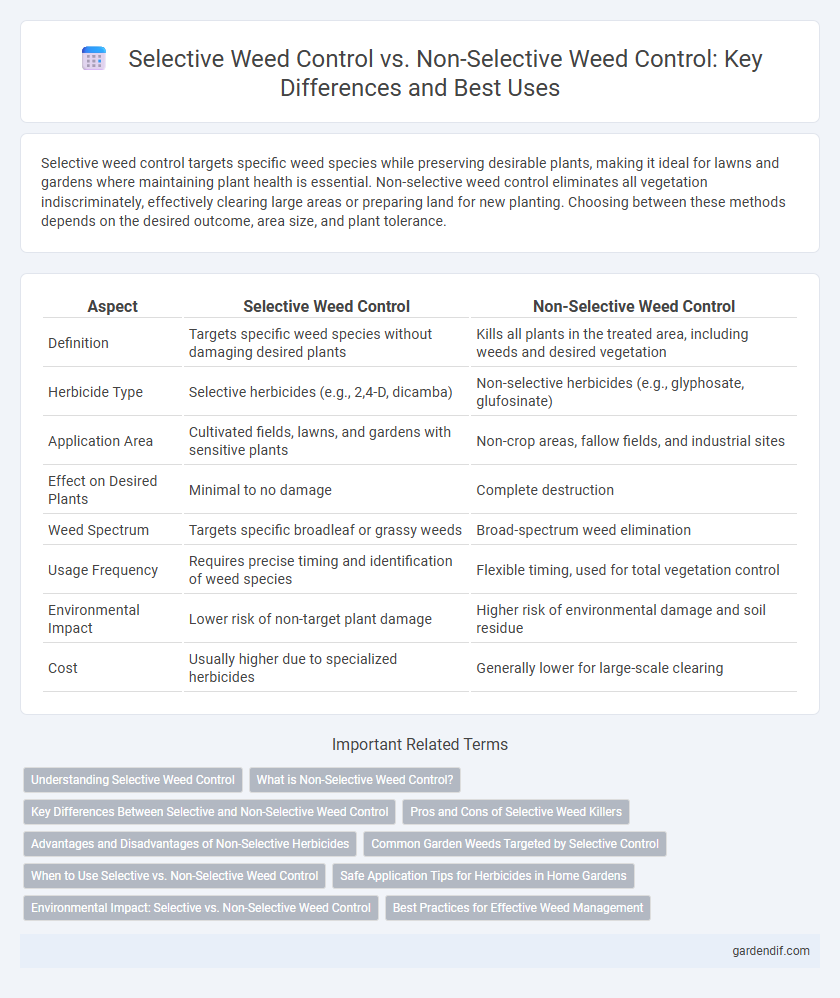
Selective weed control vs non-selective weed control Illustration
Selective weed control targets specific weed species while preserving desirable plants, making it ideal for lawns and gardens where maintaining plant health is essential. Non-selective weed control eliminates all vegetation indiscriminately, effectively clearing large areas or preparing land for new planting. Choosing between these methods depends on the desired outcome, area size, and plant tolerance.
Table of Comparison
| Aspect | Selective Weed Control | Non-Selective Weed Control |
|---|---|---|
| Definition | Targets specific weed species without damaging desired plants | Kills all plants in the treated area, including weeds and desired vegetation |
| Herbicide Type | Selective herbicides (e.g., 2,4-D, dicamba) | Non-selective herbicides (e.g., glyphosate, glufosinate) |
| Application Area | Cultivated fields, lawns, and gardens with sensitive plants | Non-crop areas, fallow fields, and industrial sites |
| Effect on Desired Plants | Minimal to no damage | Complete destruction |
| Weed Spectrum | Targets specific broadleaf or grassy weeds | Broad-spectrum weed elimination |
| Usage Frequency | Requires precise timing and identification of weed species | Flexible timing, used for total vegetation control |
| Environmental Impact | Lower risk of non-target plant damage | Higher risk of environmental damage and soil residue |
| Cost | Usually higher due to specialized herbicides | Generally lower for large-scale clearing |
Understanding Selective Weed Control
Selective weed control targets specific weed species without harming desired plants, utilizing herbicides formulated to exploit biological differences between weeds and crops. This method enhances crop yield and minimizes environmental impact by preserving beneficial plants and reducing chemical usage. Understanding selective weed control involves recognizing species-specific herbicide modes of action and timing application for maximum efficacy.
What is Non-Selective Weed Control?
Non-selective weed control refers to the use of herbicides or methods that eliminate all plants indiscriminately, affecting both weeds and desirable vegetation. Common non-selective herbicides include glyphosate and paraquat, which are effective for clearing large areas before planting or managing weed growth in non-crop zones. This approach reduces competition uniformly but requires caution to avoid damage to crops and valuable plants.
Key Differences Between Selective and Non-Selective Weed Control
Selective weed control targets specific weed species without harming desired plants, utilizing herbicides formulated to affect only broadleaf or grassy weeds. Non-selective weed control eliminates all vegetation within the treated area, commonly using glyphosate or other broad-spectrum herbicides to clear entire plots. Key differences include the scope of plant damage, application timing, and suitability for areas requiring preservation of desired crops versus complete vegetation removal.
Pros and Cons of Selective Weed Killers
Selective weed killers target specific weed species without harming desired plants, making them ideal for lawns and gardens with mixed vegetation. They minimize collateral damage to crops and beneficial plants but can be less effective against broad-spectrum weed infestations. The main drawbacks include limited weed range and potentially higher cost compared to non-selective herbicides.
Advantages and Disadvantages of Non-Selective Herbicides
Non-selective herbicides effectively eradicate a broad spectrum of weeds, making them ideal for clearing entire areas quickly and efficiently. However, their lack of specificity can result in damage to desirable plants, necessitating careful application to avoid unintended harm. This broad action limits their use in crop fields or gardens where selective plant preservation is crucial.
Common Garden Weeds Targeted by Selective Control
Selective weed control targets common garden weeds such as dandelions, crabgrass, and chickweed with herbicides that preserve desired plants by focusing on broadleaf or grassy weed species. Non-selective weed control eliminates all vegetation, posing a risk to garden plants and requiring careful application. Understanding the specific growth habits and biological characteristics of common garden weeds enhances the effectiveness of selective herbicides.
When to Use Selective vs. Non-Selective Weed Control
Selective weed control targets specific weed species without harming desirable plants, making it ideal for lawns and gardens with mixed vegetation. Non-selective weed control is effective for clearing all vegetation, commonly used in driveways, walkways, or areas undergoing renovation. Choosing between selective and non-selective herbicides depends on the desired outcome and the type of plants present in the treated area.
Safe Application Tips for Herbicides in Home Gardens
Selective weed control targets specific weed species while preserving desirable plants, making it ideal for home gardens with diverse vegetation. Non-selective weed control uses broad-spectrum herbicides that can damage any plant they contact, requiring careful application to prevent harm to garden plants. To ensure safe herbicide use, apply treatments on calm days, avoid spraying during bloom to protect pollinators, and follow label instructions precisely to minimize environmental impact.
Environmental Impact: Selective vs. Non-Selective Weed Control
Selective weed control targets specific weed species, reducing harm to desired plants and preserving biodiversity, which minimizes disruption to ecosystems and soil health. Non-selective weed control eliminates a broad range of vegetation, often leading to unintended damage to beneficial plants and increased soil erosion. This widespread damage can reduce habitat quality for pollinators and other wildlife, amplifying negative environmental impacts.
Best Practices for Effective Weed Management
Selective weed control targets specific weed species without harming desirable plants, making it ideal for gardens and lawns with mixed vegetation. Non-selective weed control eliminates all plants in the treated area, best suited for clearing driveways, mulched beds, or areas being prepared for new plantings. Integrated weed management combines selective herbicides, mechanical methods, and cultural practices to optimize weed suppression while minimizing environmental impact.
Selective weed control vs non-selective weed control Infographic

 gardendif.com
gardendif.com